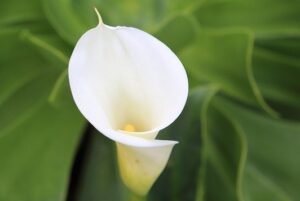This question has been asked several times and we wanted to cover it. Fish enthusiasts have been wondering –
“Are calla lilies poisonous to fish?”
Calla lilies are known to be poisonous to fish. While there isn’t direct evidence, if you’re planning on adding calla lilies – make sure that your fish isn’t able to nibble on them.
Calla lilies have “lily” in their name, but they are not actually lilies. They are native to South Africa. Calla means beautiful in Greek.
Some might think of the whole trumpet as the flower, but the flower is only the upright part in the middle. The white or colored part of the plant is actually a leaf.

They can grow beautiful flowers in a variety of colors. Moreover, you can grow them in containers outdoors or even as house plants.
You may also not know this, but you can even grow some calla lily species in water up to 12 inches deep.
Are They Poisonous To Fish?
We found no direct evidence of calla lilies being harmful to fish. However, they do have a toxic substance called insoluble calcium oxalate. When cats or dogs consume them, they suffer from pain, difficulty in swallowing, and swelling.
It irritates the gastrointestinal tract.
It is in the ASPCA‘s (American Society for the Prevention of Cruelty to Animals) list of toxic plants. But it only mentions it being poisonous to cats and dogs and not fish.
According to some garden experts, you can grow them near or inside ponds.

Still, be careful not to submerge them to the point where your pond fish could nibble on them.
While there isn’t any precise information available on whether this plant is toxic to fish or not but if it is harmful to cats, dogs, and humans, we conclude that it could harm your fish too.
Better be safe than sorry, right?
Grow these plants on the sides of pools where they cannot make contact with water.
You could also grow them in a part of a pond that doesn’t allow fish near them, i.e., behind a rock formation. But still, if you have your doubts, avoid these plants.
You can grow many other non-toxic, beautiful plants that are suitable for fish.
Why Grow Calla Lily?
- These plants are easy to grow.
- They come in a variety of colors that make your garden or pond look vibrant and pretty.
- They blossom just eight weeks after planting.
- Their foliage is arrow-shaped, which looks attractive.
Calla Lily Growth Conditions
Calla lilies grow vibrant and breathtaking flowers. They are semi-aquatic and grow from rhizomes, and they are also very easy to grow. You need to plant them in loose and well-drained soil.
They grow happily in the full sun but require partial shade in warmer climates. Moreover, you can plant them in spring when the temperatures start rising.
However, you should protect them from frost.
You should plant the rhizome about four inches deep in the soil for good results.
When you complete the planting process, water it well.
Calla Lily Care
They don’t require much care, but you need to water them properly and provide them with a healthy dose of fertilizer.
Add a good layer of mulch to the area where it grows, and that will keep it healthy, moist, and free from invasive weeds.
They need a dormant period when they stop flowering. In this time, you should stop watering it so that it dries out.
If you have grown it in a container, you should move it to a darker place when its foliage fades.
Below – you can find frequently asked questions about the calla lily.
What plants are toxic to fish?
According to koienterprise.com, tress can be harmful when they are around fish ponds. This includes:
- Rhodendron
- Oleander
- Yew
- Poplar
- Maple
- Oak
If you have any additional questions when it comes to the calla lily and fish, feel free to comment below this article. We will do our best to answer every possible question to provide future readers with a better experience.
From VivariumTips,
Calla lilies are beautiful plants with vibrant-colored flowers. They contain insoluble calcium oxalate. While they are toxic to dogs and cats if eaten, they don’t kill them. However, they can cause GI tract issues. Based on the scientific evidence and experience of some fish keepers, some varieties of the calla lily are poisonous to eat. Thus, if you’re growing them, do so in a place where fish can’t eat them.
For related articles about plants and fish, check out:
- List of Plants That Can Poison Fish
- List Of Plants Safe For Fish Pond
- Are Ferns Poisonous To Fish?
- Are Pine Needles Poisonous To Fish?
You can find out calla lilies bestselling products below!
[amazon bestseller=”calla lily flower” items=”3″ ]

